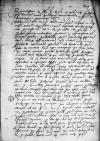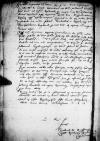Deliberaveram Vestram Reverendissimam Paternitatem, dominum meum gratiosum, visitare meumque casum eventivum significare, verum aegritudo et infirmitas{que} me paratissimum ad Vestram Reverendissimam Paternitatem ullo modo permisit, etiam conventus velocissimi particulares in nos constituti ante ⌊conventum generalem⌋ Pyothrkoviensem proxime futurum super festum Trium Regum.
Sicque, dum equitaveram ante medium unius anni proficiscendo ad conventum particularem ad ⌊Szroda⌋, in terra Posnaniensi sita, de mandato sacrae ⌊regiae maiestatis⌋, in obvio habui in itinere eventive quendam ⌊Lyubranski⌋ castellanum Brzesthensem, inimicum suum diffidantem et qui causam litis per famulos suos incepit. ⌊Is⌋ a servis meis erat vulneratus dumque perveni, aegritudine et infirmitate oppressus protunc existens, descendens de curru cunabulari alias s kolyepki, equum ascendens, illum ultra verberare non permisi, sed in his vulneribus decessit. Et sic dum eventive evenit, et casus eventivus super quoslibet status volat, animo bono et consilio dominorum amicorum et domini ⌊de Lasko⌋ palatini Siradiensis, fratris mei, ad Vestram Reverendissimam Paternitatem humillibus petitionibus confugi, rogans pro intercessione ad sacram ⌊maiestatem regiam⌋, dominum nostrum, prout dominum meum a iuventute mea bene mihi conservatum. Nam sum per ⌊regiam maiestatem⌋ citatione horribili ac inconsueta pro tempore superius descripto citatus. In qua re etiam ⌊⌋ ad illustrissimum ⌊principem Prussiae⌋. Tandem rogo ad eundem ⌊principem⌋ pro intercessione in causis meis adversis, ab eodem quoque Vestra Reverendissima Paternitas dignetur rescire, constitueturne ⌊Pyothrkowyae⌋ pro ⌊conventu generali⌋ proxime futuro an non. In quantum non constituerit, precor, ut eandem causam meam Vestra Reverendissima Paternitas, committeretur, dignaretur, pro illo tempore, dum etiam dominus ⌊palatinus Siradiensis⌋, frater meus, et alii domini ⌊Coronae⌋ constituentur, videlicet pro prima Dominica post festum Conversionis Sancti Pauli, hoc est in tribus septimanis post festum Trium Regum. Quod minime dubito id Vestram Reverendissimam Paternitatem facturam, dominum meum ex iuventa mihi gratiosum.
Novitates Ungaricales non lateant Reverendissimam Paternitatem Vestam, sunt infrascriptae. In redeundo de ⌊Leopoli⌋ descenderam ad dominum ⌊palatinum Siradiensem⌋, fratrem suum, ad ⌊castrum Szaharosz⌋, quod accepit cum domino ⌊Leonardo⌋ ductore exercituum ⌊regis Romanorum⌋, comite suo. Et protunc advenerat exercitus regis ⌊Ioannis Ungariae⌋ continens in se XI milia hominum includendo tria milia peditum, bombardas, id est dzyal, XX et ultra habebant. Sagittando per tres dies idem exercitus cum magna levitate rediit.
⌊Regis etiam Romanorum⌋ exercitus continebat in se quattuor milia hominum peditum et duo hominum Polonorum cum domino ⌊de Lasko⌋ palatino Siradiensi. Miserunt tandem ad dominum ⌊palatinum Siradiensem⌋, ut cum eis congrederetur, et dixerunt per dominos ⌊palatinum Szyedmygroczensem⌋ et dominum ⌊Petrum de Pereni⌋: “Quod ob eam causam congressum et bellum retinemus, quoniam te hic videremus et te auro et argento emeremus” et multa verba amicabilia, ad concordiam attrahentia inter se et inter illustrissimos ⌊reges⌋ statuendo dixerunt. Circa omnia praemissa fui, id Vestrae Reverendissimae Paternitati significo, domino mihi gratioso.
Haec concordia nullo alio corrupta videri possit inter ⌊reges Ungariae et Romanorum⌋, dumtaxat casu militis ⌊Coczyan⌋ cum alio exercitu ⌊regis Romanorum⌋ continente in se XV milia hominum in ⌊terra Szlovynensi⌋, qui per astutiam permisit se a ⌊Turcis⌋ defraudari, vi
<n>
ci ac debellari, cui dominus ⌊palatinus Siradiensis⌋ ad ⌊regem Romanorum⌋ treugas pacis capit, prout sum edoctus.
Quam tandem Reverendissimam Paternitatem Vestram plurimos in annos feliciter dominari et vivere in meum solacium aeternum opto.


